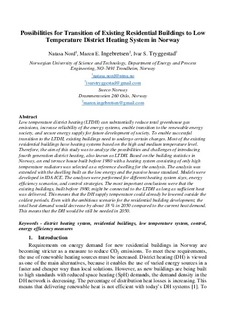Possibilities for Transition of Existing Residential Buildings to Low Temperature District Heating System in Norway
Chapter
Accepted version
Permanent lenke
http://hdl.handle.net/11250/2581411Utgivelsesdato
2016Metadata
Vis full innførselSamlinger
Sammendrag
Low temperature district heating (LTDH) can substantially reduce total greenhouse gas emissions, increase reliability of the energy systems, enable transition to the renewable energy society, and secure energy supply for future development of society. To enable successful transition to the LTDH, existing buildings need to undergo certain changes. Most of the existing residential buildings have heating systems based on the high and medium temperature level. Therefore, the aim of this study was to analyze the possibilities and challenges of introducing fourth generation district heating, also known as LTDH. Based on the building statistics in Norway, an end terrace house built before 1980 with a heating system consisting of only high temperature radiators was selected as a reference dwelling for the analysis. The analysis was extended with the dwelling built as the low energy and the passive house standard. Models were developed in IDA-ICE. The analyses were performed for different heating system sizes, energy efficiency scenarios, and control strategies. The most important conclusions were that the existing buildings, built before 1980, might be connected to the LTDH as long as sufficient heat was delivered. This means that the DH supply temperature could already be lowered outside the coldest periods. Even with the ambitious scenario for the residential building development, the total heat demand would decrease by about 18 % in 2050 compared to the current heat demand. This means that the DH would be still be needed in 2050. Possibilities for Transition of Existing Residential Buildings to Low Temperature District Heating System in Norway
